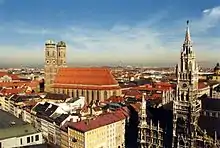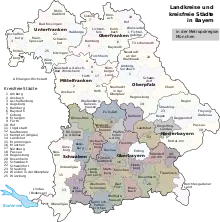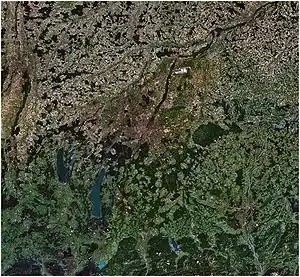Munich Metropolitan Region
The Munich Metropolitan Region is one of eleven metropolitan regions in Germany, consisting of the agglomeration areas of Munich, Augsburg, Ingolstadt, Landshut, Rosenheim and Landsberg am Lech. It is Germany's fifth most populous metropolitan region after the Rhine-Ruhr Metropolitan-Region, the Frankfurt Rhine-Main-Region, the Berlin-Brandenburg Metropolitan-Region and the Stuttgart Metropolitan-Region.

Central Munich

Map of Bavaria and the Munich Metropolitan Region, with members highlighted
Metropolitan Region
- State: Bavaria
- Districts: Lower Bavaria, Upper Bavaria, Swabia
- Area: 27,700 km2 (40% of the state of Bavaria)
- Population: 5,991,144[1]
- GDP: 210 billion euro (53% of the Bavarian GDP)
In comparison to the other ten German Metropolitan Regions, the Munich Metropolitan Region had:
- the highest population growth (about 5% from 1997 to 2004)
- the largest increase in employment (over 5% from 1997 to 2004)
- the highest gross value added per employed person (2003)
- the highest tax revenue per inhabitant (2003)
Larger Urban Zone

Satellite view of the Munich Larger Urban Zone
The Munich Larger Urban Zone (LUZ) as defined by Eurostat's Urban Audit covers an area of 5,500 km2 and in 2004 contained 2,531,706 inhabitants[2] (pop. density 460,31/km2). The Larger Urban Zone covers the following cities and districts:[3]
- Stadt München
- Landkreis Dachau
- Landkreis Ebersberg
- Landkreis Erding
- Landkreis Freising
- Landkreis Fürstenfeldbruck
- Landkreis Landsberg am Lech
- Landkreis München
- Landkreis Starnberg
References
- "Daten und Fakten aus der Metropolregion München" [Data and facts about the Munich Metropolitan Region]. Europäische Metropolregion München e.V. Retrieved 20 June 2019.
- "München". Archived from the original on 14 September 2009. Retrieved 15 June 2009.
- http://www.staedtestatistik.de/507.html Archived 2009-09-12 at the Wayback Machine Retrieved 15 June 2009.
External links
- Official website (German)
- Initiative for European Metropolitan Regions in Germany (German)
This article is issued from Wikipedia. The text is licensed under Creative Commons - Attribution - Sharealike. Additional terms may apply for the media files.